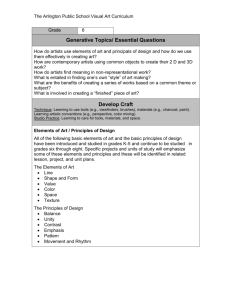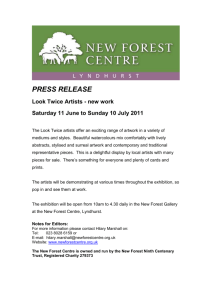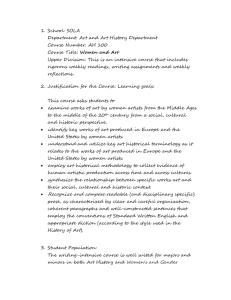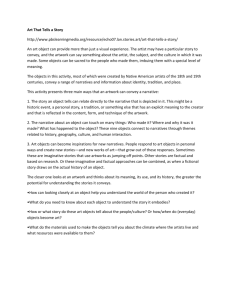Grade 7 - WordPress.com
advertisement
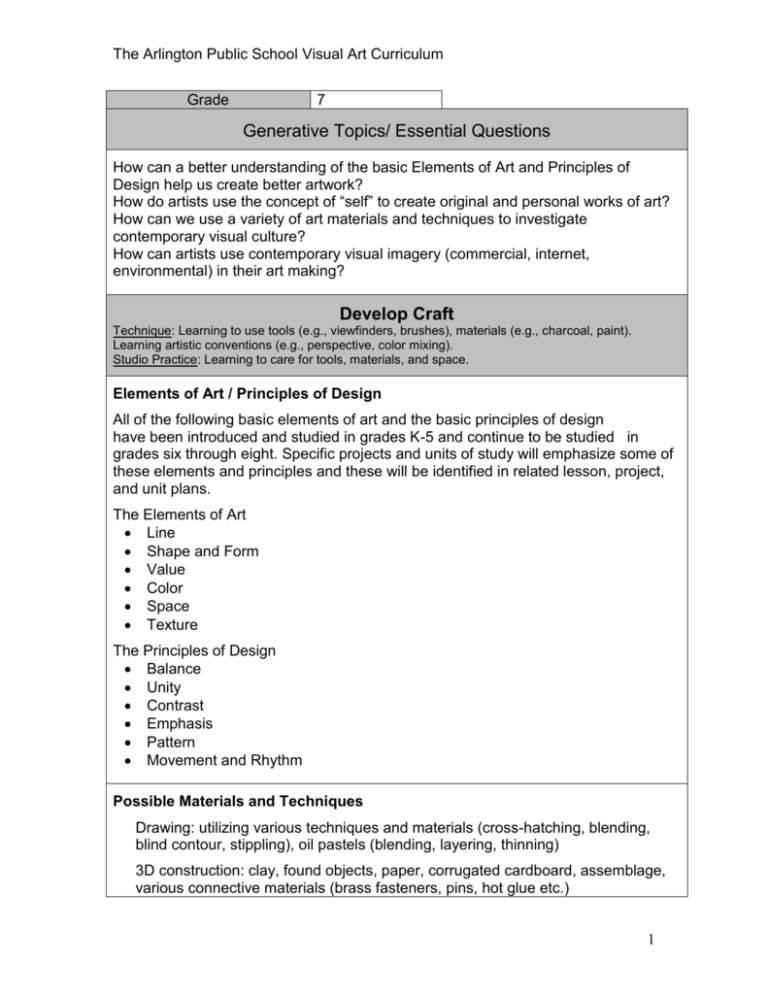
The Arlington Public School Visual Art Curriculum Grade 7 Generative Topics/ Essential Questions How can a better understanding of the basic Elements of Art and Principles of Design help us create better artwork? How do artists use the concept of “self” to create original and personal works of art? How can we use a variety of art materials and techniques to investigate contemporary visual culture? How can artists use contemporary visual imagery (commercial, internet, environmental) in their art making? Develop Craft Technique: Learning to use tools (e.g., viewfinders, brushes), materials (e.g., charcoal, paint). Learning artistic conventions (e.g., perspective, color mixing). Studio Practice: Learning to care for tools, materials, and space. Elements of Art / Principles of Design All of the following basic elements of art and the basic principles of design have been introduced and studied in grades K-5 and continue to be studied in grades six through eight. Specific projects and units of study will emphasize some of these elements and principles and these will be identified in related lesson, project, and unit plans. The Elements of Art Line Shape and Form Value Color Space Texture The Principles of Design Balance Unity Contrast Emphasis Pattern Movement and Rhythm Possible Materials and Techniques Drawing: utilizing various techniques and materials (cross-hatching, blending, blind contour, stippling), oil pastels (blending, layering, thinning) 3D construction: clay, found objects, paper, corrugated cardboard, assemblage, various connective materials (brass fasteners, pins, hot glue etc.) 1 The Arlington Public School Visual Art Curriculum 2D construction: collage, assemblage, found objects, paper, corrugated cardboard, mod podge, acrylic medium Printmaking: block printing, mono printing, relief printing, collography Painting: acrylic (washes, impasto) and watercolor (dry brush, wet-on-wet, transparencies) Observe Learning to attend to visual contexts more closely than ordinary “looking” requires, and thereby to see things that otherwise might not be seen. Students will: create 2D and 3D representational artwork from direct observation in order to develop skills of perception, discrimination, physical coordination, and memory of detail (3.4) look closely at artwork by other artists (including their peers) and analyze the meaning of that work and its impact on society and be able to discuss various visual attributes of that work. compare works from several different cultures and explain how each reflects function, customs, religious beliefs, social philosophies, and aesthetic theories. Reflect Question & Explain: Learning to think and talk with others about an aspect of one’s work or working process. Evaluate: Learning to judge one’s own work and working process and the work of others in relation to standards of the field. Students will: demonstrate the ability to describe the kinds of imagery used to represent subject matter and ideas, for example, literal representation, simplification, abstraction, or symbolism (5.6) 2 The Arlington Public School Visual Art Curriculum demonstrate the ability to describe preliminary concepts verbally; to visualize concepts in clear schematic layouts; and to organize and complete projects (4.5) demonstrate the ability to articulate criteria for artistic work, describe personal style, assess and reflect on work orally and in writing, and to revise work based on criteria developed in the classroom (4.6) actively participate in oral group critiques of peer work and in group discussions about professional artists’ work. Engage and Persist Learning to embrace problems of relevance within the art world and/or of personal importance, to develop focus and other mental states conducive to working and persevering at art tasks. Students will: maintain a portfolio of sketches and finished work (4.7) demonstrate the ability to recognize and describe the visual, spatial and tactile characteristics of their own work and that of others (5.5) develop the ability to conceptualize, organize, and complete long-term projects alone and in groups. develop the ability to continually revise their work and this includes being able to work on an idea through multiple stages, responding to criticism and self- assessment. begin to develop the capacity to change a work in progress based on their personal preferences while balancing the requirements of the assignment. 3 The Arlington Public School Visual Art Curriculum Envision Learning to picture mentally what cannot be directly observed and imagine possible next steps in making a piece. Students will: create artwork that shows knowledge of the ways in which architects, craftsmen and designers develop abstract symbols by simplifying elements of the environment (3.7) develop the ability to use their imaginations to draw, paint and sculpt places, human characters, creatures, objects and other imagery that does not previously exist and develop the ability to create contexts for this imagined imagery. anticipate and predict with greater accuracy the outcomes of certain actions that they decide to take in their work. develop the ability to imagine how their work in progress will benefit and lead to future works that they will attempt to create. develop the ability to reflect on other artists’ work including other students’ work and envision how aspects of that work can relate to and benefit the progress of their own works in progress. 4 The Arlington Public School Visual Art Curriculum Express Learning to create works that convey an idea, a feeling, or a personal meaning . Students will: develop the ability to work on an idea through multiple stages, responding to criticism and self-assessment. develop the ability to express their own personal interests, feelings, ideas and style through their art making. develop the ability to use representation, abstraction, or symbolism to create 2D and 3D artwork that conveys a personal point of view about issues and ideas. develop the ability to analyze and interpret the expressive and personal messages contained in other artists’ work. Stretch & Explore Learning to reach beyond one's capacities, to explore playfully without a preconceived plan, and to embrace the opportunity to learn from mistakes and accidents. Students will: explore a single subject through a series of works, varying the medium or technique. create artwork that demonstrates facility in selective use of elements and principles of design to establish a personal style. develop the ability to work on an idea through multiple stages, responding to criticism and self-assessment (4.10) use published sources, either traditional or electronic, to research a body of work 5 The Arlington Public School Visual Art Curriculum or an artist, and present findings in written or oral form. begin to understand how to push the limits of the materials to discover original techniques and effects in their work. This includes accepting the “accident” as an integral part of the creative process. develop the confidence to work “outside of their comfort zones” as they explore the full capacities and nuances of the materials as well as their personal ideas and feelings. Understand Art World Domain: Learning about art history and current practice. Communities: Learning to interact as an artist with other artists (i.e., in classrooms, in local arts organizations, and across the art field) and within the broader society. Students will: Describe how artistic production can shape and be influenced by the aesthetic preferences of a society (6.4) identify and describe the examples of the persistence of traditional historical materials and technologies in contemporary artworks (9.7) interpret the meanings of artistic works by explaining how the subject matter and/or form reflect the events, ideas, religions, and customs of people living 6 The Arlington Public School Visual Art Curriculum at a particular time in history (6.3) investigate how artists create their work; read about, view films about, or interview artists such as choreographers, dancers, composers, singers, instrumentalists, actors, storytellers, playwrights, illustrators, painters, sculptors, craftspeople, or architects (7.1) describe the roles of artists in specific cultures and periods, and compare similarities and differences in these roles, considering aspects such as: • the conditions under which artists created, performed, and/or exhibited work and the status of artists; • the sources of support for the arts; and • the ways, such as apprenticeship or training, in which students learned the skills and knowledge that qualified them to produce or perform artistic work (7.2) describe the function of cultural organizations and arts institutions such as museums, symphonies, repertory theatres, dance companies, and historical preservation organizations (7.4) identify American styles and genres of dance, music, theatre, of visual arts and architecture, describe their sources, trace their evolution, and cite well-known artists associated with these styles (8.4) identify and describe examples of how artists make innovative use of technologies and inventions (9.3) Example of graphics in contemporary professional artwork Chuck Close, Self Portrait, 2007 7 The Arlington Public School Visual Art Curriculum Pablo Picasso, Weeping Woman, 1937 Example of graphic text used in contemporary professional artwork Salvador Dali, Persistence of Memory, 1931 Rene Magritte, Time Transfixed, 1938 Andy Warhol, Campbell’s Soup Can, 1964 Shephard Fairey, Obama presidential election poster, 2008 8 The Arlington Public School Visual Art Curriculum 9

